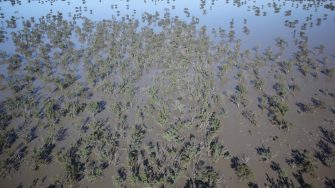
Date: Thursday, November 10, 2016
Project: Eastern Australian Waterbird Survey
Observer: Richard Kingsford
Yesterday evening we flew over our first wetland that we needed to survey today – Bogandillon Swamp, part of the Lachlan River. With all the flooding earlier in the year it had overflowed its capacity.
Bogandillon Swamp in the late afternoon
We had a glorious morning, not a breath of wind and sunshine. Surveying over Bogandillon Swamp was wonderfully smooth – perfect flying and counting conditions. The Swamp was so large that it had become a lake. And if we wondered where all the waterbirds were – they were on the Lachlan River wetlands. There were larger flocks of teal and wood duck than we had seen during all of our surveys, across eastern Australia. There were also nesting whiskered terns where there was vegetation.
Surveying Bogandillon Swamp in the early morning
Bogandillon Swamp
After we had finished flying twice around the swamp, we went south to Nerang Cowal, part of the Lake Cowal lake system. This area, normally a small overflow from Lake Cowal, had become a large lake which took us some time to circumnavigate. As with all the wetlands of the Lachlan system, it was at about 120% capacity. It also had waves of waterbirds coming out from in front of the plane. Next was Lake Cowal.
Nerang Cowal
I have visited Lake Cowal for more than 30 years but nothing prepared me for the size of the lake and its ‘blow-out’ in all directions, flooding nearby farmlands. Even in a small plane it was not possible to go around the full extent of the wetland.
Surveying the central part of Lake Cowal
We were also not quite prepared for the numbers and diversity of waterbirds. Unlike so many other lakes and floodplains, Lake Cowal had many species and reasonably large numbers, perhaps up to 10,000 waterbirds. There were large flocks of teal, Australasian shoveler, whiskered terns, hardhead and then many herons which usually only occur in ones and twos – white-faced herons and white-necked herons.
Lake Cowal had spread in all directions
There were breeding royal spoonbills, whiskered terns, a couple of small ‘patches’ of breeding Australian white ibis and even a magpie goose nest. It has been very encouraging to see one or two magpie geese on the Murray-Darling Basin wetlands, once a strong hold for the species but then either shot out or poisoned. We finally finished our surveys for this week. Next week, we head north across the Murray-Darling Basin for our last leg this year.
